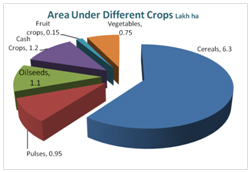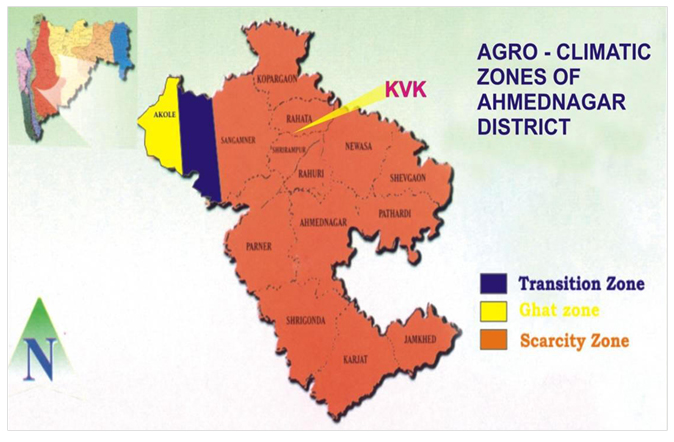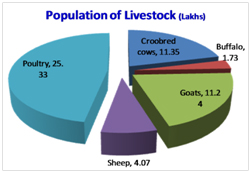District General Details
The Ahmednagar District lies in the central part of the state of Maharashtra which is having common boundaries with seven adjoining Districts. Ahmednagar is the biggest district of Maharashtra in terms of area and population.

The total geographical area of the district is 17.41 lakh ha. The net cropped area is 12,56,500 ha, out of which an area of 3,30,000 ha. (26.27 %) is under canal (84,000 ha) and well irrigation. About 9,26,500 ha.( 73.73 %) area is rain fed. The area under Kharif crops is 4,60,000 ha. (36.6 per cent) while 7,58,000 ha (60.32 per cent) area is under Rabi crops. A multiple cropping system is followed on 1,10,500 ha. area. A total of 8.73 per cent area of the district is under forest.
Soil Type
The soil types of the district are broadly divided into four categories namely coarse shallow soil; medium black soil; deep black soil and reddish soil occupying about 38, 41, 13 and 8 percent of the cultivated area respectively. In the first two categories, soil moisture is the predominant limiting factor affecting productivity of crops particularly under rainfed condition.
Rainfall and Temperature
The climate of the district is hot and dry, on whole extremely genial and is characterized by a hot summer and general dryness during major part of the year except during south-west monsoon season. Ahmednagar district receives average 566 mm. rainfall. The major rainfall received during month of June to September. The average temperature ranges between 9 0c (during Dec.) to 41 0C (during April and May).
Water Resources
On an average 26.27 per cent of the cultivated area is under irrigation, out of which 71.46 per cent is under well irrigation (including lift irrigation) and remaining area is under canal irrigation. In the northern part of the district there are 3 major irrigation projects namely upper Godavari, Pravara and Mula having 2, 18 and 28 per cent of the irrigated areas. In the south-western part of the district there are two command projects (namely Ghod & Kukadi) which are having 15 per cent of the irrigated area. Besides this, there are 7 medium projects and 90 minor projects covering 16 and 5 percent of the total irrigated areas.
Agro Climatic Zones
Ahmednagar district is mainly recognized as multidimensional situation. District is divided into three agro climatic zones viz. Scarcity Zone, Plain (Transition) zone and Ghat (Hilly) zone.

Scarcity Zone
This zone is occupied the whole district except one block i.e. Akole, the remaining 13 blocks are under this zone. The average rainfall of this zone ranges from 400 to 600 mm. About 70-80 per cent of annual rainfall is received during monsoon period (June to September). Soil varies from reddish brown to dark gray and commonly grouped as light to medium black soil. In very few places deep black soil is also observed. Erratic nature of rainfall affects the moisture content in the soil, therefore, this zone is commonly known as drought prone area. Major crops grown in this zone are pearl millet, sorghum, safflower, bengal gram, wheat, sugarcane etc.
Plain (Transition) Zone
This zone is confined only to eastern part of Akole block. Geographically this zone has only 4% of the district area. The rainfall in this zone is 700 to 1250 mm annually which is well distributed. Soils are grayish black with varying texture and depth. The main crops grown in this region are pearl millet, green gram, benegal gram and wheat. Due to irrigation facility, farmers are growing. Vegetables like tomato, gourds and fruit crops like pomegranate, mango and Sugarcane.
Ghat (Hilly) Zone
This zone is situated in northwestern part of the district in western part of Akole block. Geographically this zone has only 4 per cent of the district area. The rainfall in this zone is very high which ranges from 1500 to 3000 mm. The land is mostly covered with forest and sometimes acidic in nature having poor fertility with low phosphorus and potash contents. About 50 percent of the geographical area of this zone is under forest. The crops taken in kharif season are paddy, ragi, groundnut, pulses and niger. The vegetables are also grown in paddy terraces on residual moisture.
Agro Ecological Situations (AES)
On the basis of soil types and sources of irrigation, the district has been categorized into eight Agro Ecological Situations(AES) viz. assured and unassured irrigation system in command area with medium and light soil and the rainfed area with black cotton, medium as well as light soils. The existing farming systems being adopted by majority of farmers in rainfed area of district are characterizes by existence of food grain crops including mostly bajra, Jowar as cereals and mung, udid, and tur as pulse crops in combination with dairy and animal husbandry . The analysis of the farming systems in command areas indicates the dominance of sugarcane as a cash crop with dairy as an inseparable combination and it is being supplemented by either vegetables and food grain crops or horticultural crops.
Socio - Economic and Agriculture Situation in the District
Total population of the district is 40.88 lakhs of which 32.84 lakhs is living in the rural area whereas 8.04 lakhs lives in urban area. The literacy of the district is 75.82 per cent. The female to male ratio of the district is 941. In the district, there are 6.8 lakh farming families, out of these 32.45 per cent farmers are having less than 2 ha land holding, 57.89 per cent farmers are having land holding between 2-10 ha. and 9.66 per cent farmers have a land holding with more than 10 ha. Total 3.8 lakhs are agriculture laborer, 7.88 lakhs are SC/ST population, 2.11 lakh are dairy and sheep owners and total working population is 14.32 lakh
Agricultural Technology Resource Centre
The work area of KVK Ahmednagar falls within the jurisdiction of Mahatma Phule Krishi Vidyapeeth, Rahuri which as main research and extension campus at Rahuri catering to various technological research work on arid zone fruits, grapes, vegetables, aromatic and medicinal plants and its constituent research stations at Chas for dry land crop research, Savli Vihir for oilseeds and pulses crop research, Shrirampur for coordinated research on citrus within Ahmednagar District. Apart from this the Bhabha Atomic Research Centre, Mumbai has initiated an Onion Irradiation Project near Rahuri for extending support for irradiation project of onion on cooperative basis. The leading crops grown in Ahmednagar district are pearl millet, sugarcane, cotton, soybean, red gram in kharif and sorghum, wheat, bengalgram and onion in rabi season. The crops that occupy minor area but are an important source of livelihood security are maize, greengram, blackgram, groundnut The leading horticultural crops of the Ahmednagar District are mango, lime, pomegranate, guava and onion while banana, custardapple, ginger and turmeric crops are some prominent crops which have registered a phenomenal rise in area.
The fertilizer use consumption statistics shows that the state has an imbalanced fertilizer use pattern in terms of NPK which is 6.8:2.5:1 that of Ahmednagar district is 5:3:1 as per the 2003-2004 fertilizer use estimates. This shows an imbalanced fertilizer use prevalent amongst farmers.The Agricultural Productivity of Major Cultivated Crops in Ahmednagar District is as follows:

| S.N. | Name of Crop | Area (ha) | Existing Productivity (ha) | Productivity Potential (ha) | Gap in Productivity (ha) | Technologies Available |
|---|---|---|---|---|---|---|
| 1 | Sorghum | 486559 | 0.9 | 1.5 | 0.6 | 45 cm wide Sowing, HYVs, INM, Seed Treatment |
| 2 | Pearl Millet | 191082 | 0.776 | 1.1 | 0.4 | HYVs, Drought Tolerant Varieties, Seed Treatment, In Situ Water Conservation |
| 3 | Sugarcane | 126041 | 75 | 125 | 50 | Paired Row, Broad Furrow, Single / Two eye - bud planting, , Micro Irrigation, INM, IPM |
| 4 | Wheat | 124980 | 1.8 | 2.4 | 0.6 | HYVs, INM, Seed treatment |
| 5 | Cotton | 109038 | 0.32 | 0.5 | 0.18 | Wide Row Sowing, IPM, INM, Micro Irrigation, Mechanization |
| 6 | Bengalgram | 100032 | 0.85 | 1.2 | 0.4 | HYVs, IPM, INM |
| 7 | Soybean | 50346 | 0.937 | 1.4 | 0.5 | HYVs and Short Duration Varieties, IPM, INM |
| 8 | Redgram | 14000 | 0.85 | 1.2 | 0.4 | Short Duration, IPM, Intercropping |
The Profile of Horticultural Crops in the Ahmednagar District is as follows:
| S.N. | Name of Crop | Area (ha) | Existing Productivity (ha) | Productivity Potential (ha) | Gap in Productivity (ha) | Technologies Available |
|---|---|---|---|---|---|---|
| 1 | Mango | 14113 | 7.5 | 9.0 | 1.5 | High Density Plantation, Iimproved Varieties, Micro Irrigation, IPM, INM |
| 2 | Lime | 12910 | 12 | 20 | 8 | Improved Varieties, Hasta Bahar Regulation, Micro Irrigation, IPM, INM |
| 3 | Pomegranate | 8348 | 8.5 | 15 | 6.5 | Improved Varieties, Bahar Management, Micro Irrigation, IPM, INM |
| 4 | Guava | 5220 | 20 | 30 | 10 | Meadow Orchard, Bahar Management, Micro Irrigation, IPM, INM |
| 5 | Onion | 69978 | 17 | 22 | 5 | Raised Bed Planting, Micro Irrigation, IPM, INM, Weed Management |
The Profile of Livestock Situation in Ahmednagar District is as follows:
| S.N. | Name of Crop | Population | Existing Productivity | Productivity Potential | Gap in Productivity | Technologies Available |
|---|---|---|---|---|---|---|
| 1 | Crossbred Cow | 243714 | 10-12 lit Milk / Day | 20 lit Milk / Day | 11 lit Milk / Day | Improved fodder and feed, Disease Diagnostics, Assured Conception |
| 2 | Buffalo | 67104 | 6.5 lit Milk / Day | 10 lit Milk / Day | 3.5 lit Milk / Day | Improved Fodder and Feed, Disease Diagnostics |
| 3 | Sheep | 394994 | 1 Kid / Sheep / Year | 1.5 Kid / Year | 0.5 Kid / Year | Disease Diagnostics, Breed Up - Gradation |
| 4 | Goat | 1055767 | 0.6 Kid / Goat / Yr | 1.0 Kid / Yr | 0.4 Kid / Yr | Stall Fed System, Breed Upgradation |
| 5 | Poultry | 2139029 | 1.2 kg/ Bird | 1.7 kg/ Bird | 0.5 kg/ Bird | Disease Diagnostics, Breed Up - Gradation |
The marketing avenues comprise 14 Agricultural Produce Marketing Committees 26 Agricultural Produce Sub Committees in Ahmednagar District. There are also two leading marketing centers for livestock at Loni and Ghodegaon. The MPKV Rahuri, KVK Ahmednagar and Shirdi, Ahmednagar have weather recording stations for monitoring of weather conditions within Ahmednagar District. There are two FM Stations, one at KVK Babhaleshwar and the other Prasar Bharati AIR FM Station at Ahmednagar, two private FM Stations and one TV Relay Centre of Doordarshan at Ahmednagar catering to information and entertainment needs of the community. There are five Newspaper dailies that are publishing news and other agricultural information within Ahmednagar District.

